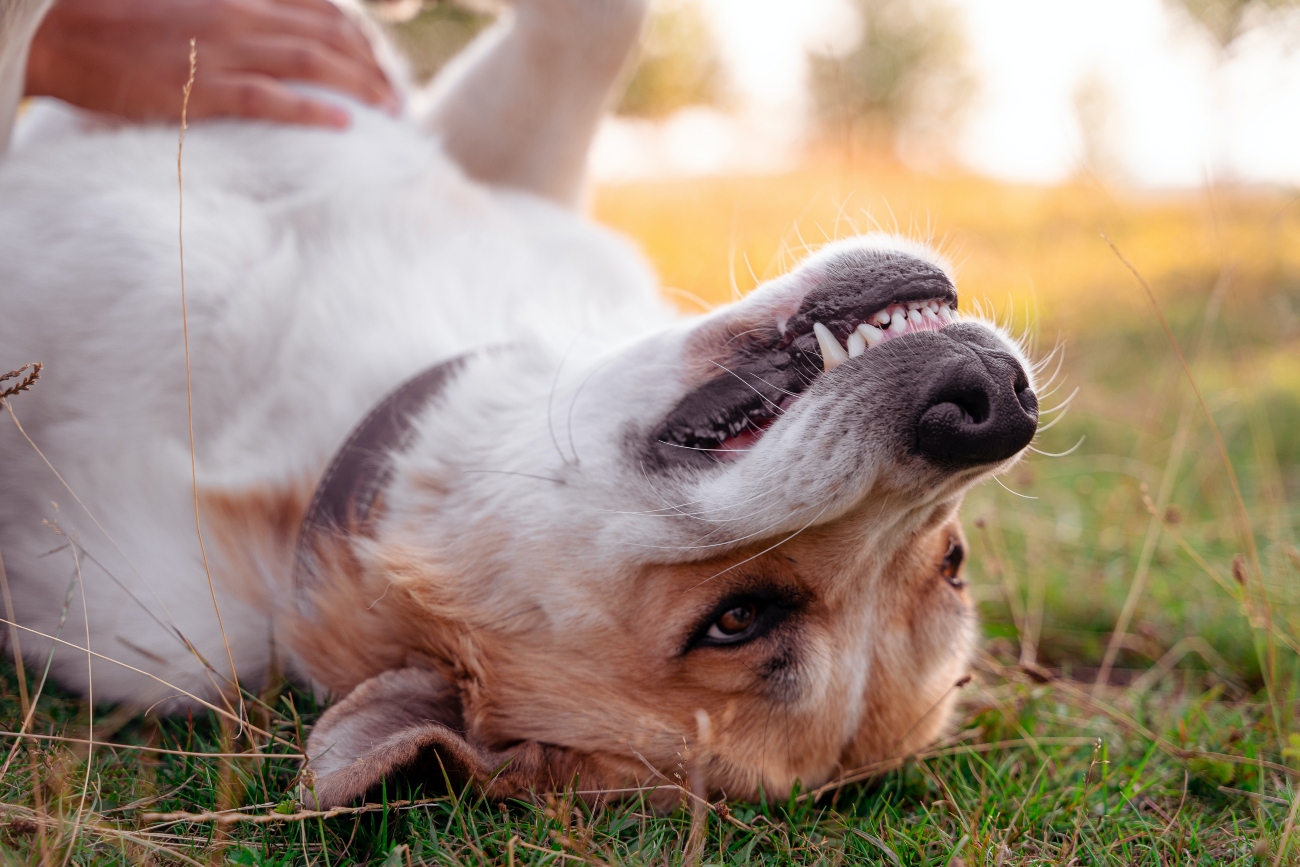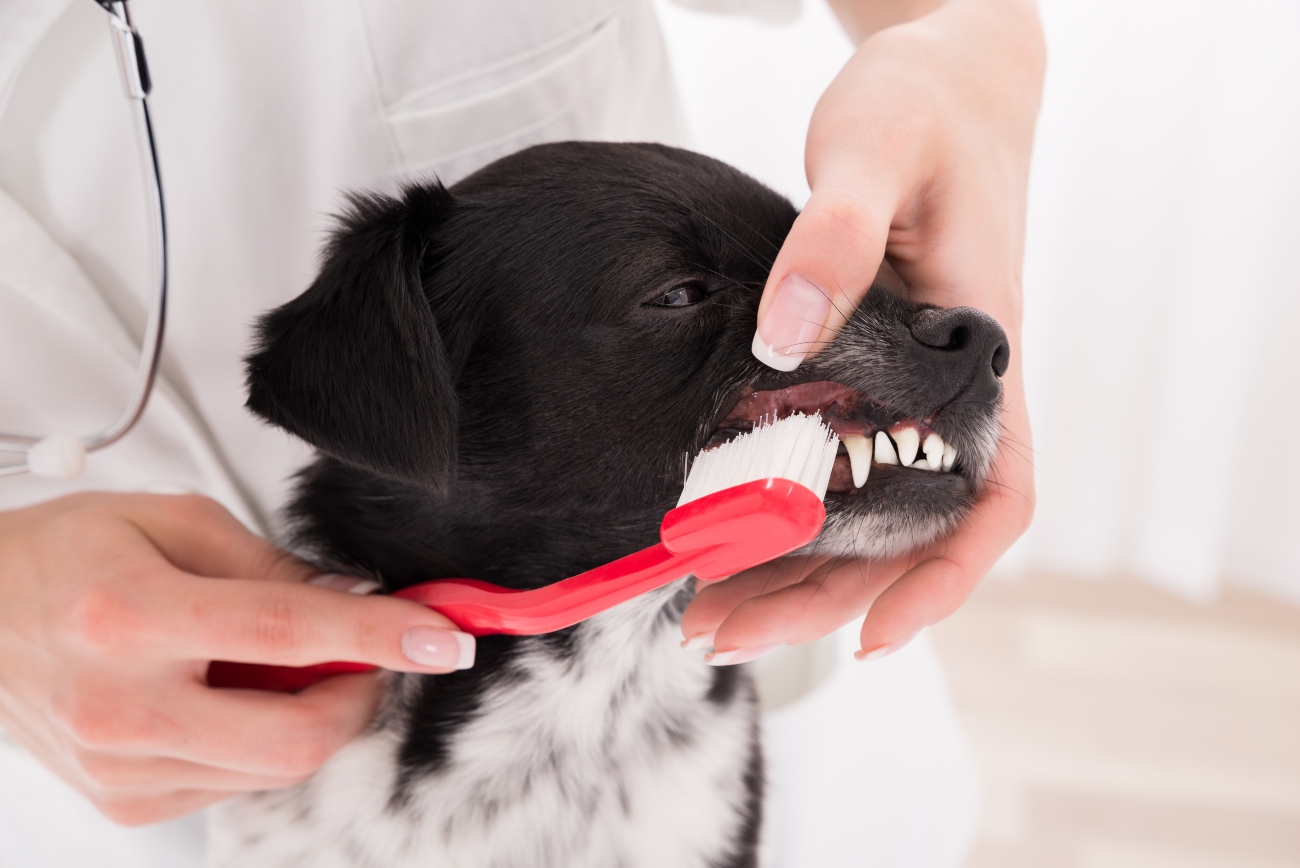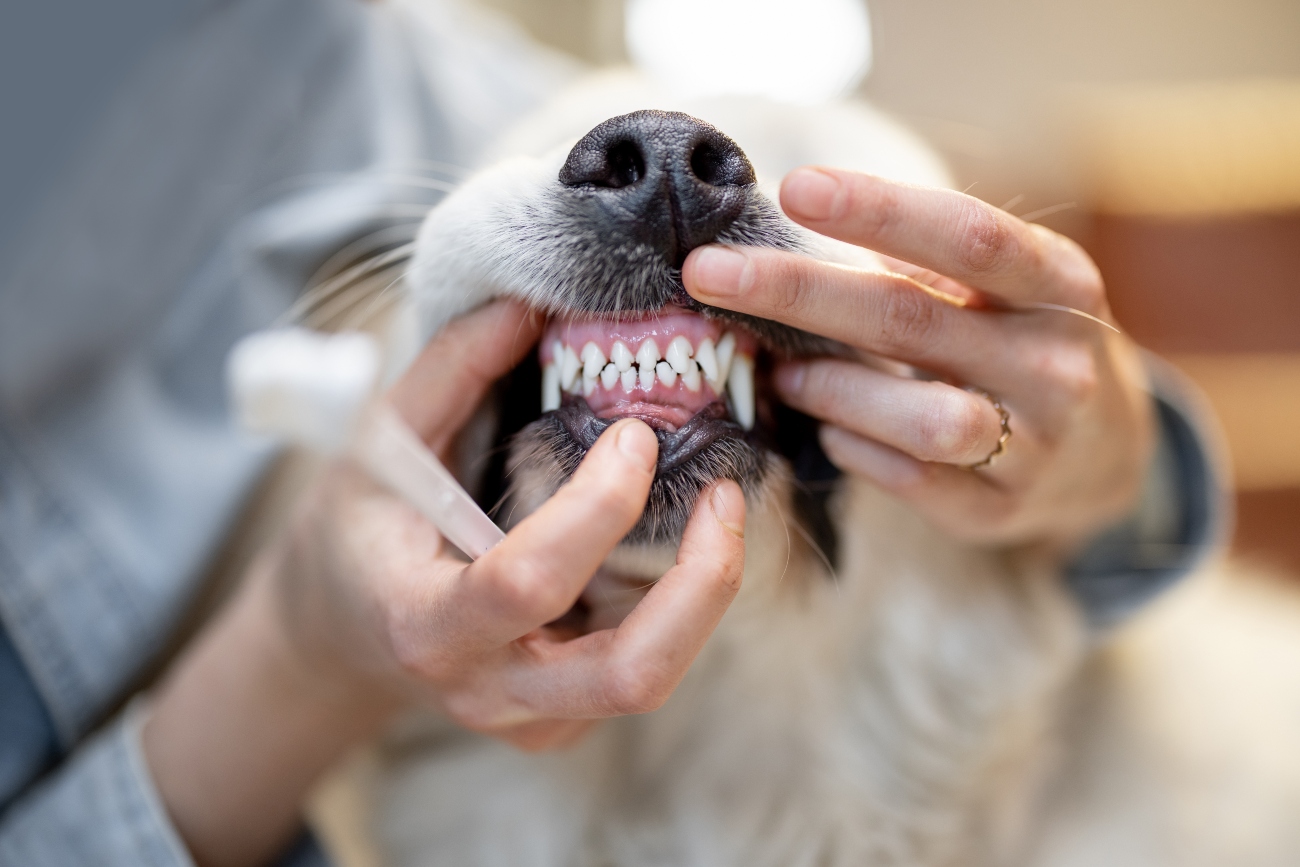
How To Clean Your Dogs' Teeth & 8 Tips For Oral Hygiene
4th August, 2022
How To Clean Dog’s Teeth & 8 Tips For Oral Hygiene
You want your dog to live a long and healthy life – good oral hygiene is essential for keeping your pet happy and in top form. Not to mention, doggy tooth cavities can prove expensive if you don’t have pet insurance that covers dental, adding up to a substantial amount over time.
One in every eight dogs in the UK (12.5%) suffers from dental disease every year. What do you need to do to keep your dog’s mouth clean, fresh and healthy?
Brushing your dog’s teeth daily
You should brush your dog’s teeth daily with a dog toothbrush and a canine toothpaste. Don’t use human toothpaste as this can be toxic to dogs. It’s best to support your dog’s oral health from the time they are a puppy, so they won’t resist the process and will see it as part of the normal daily routine. Most puppies will let you brush their teeth with a finger brush to keep them clean.
However, if your dog is a little older you can introduce toothbrushing – it’s never too late to start. You might need to take things slowly, getting your pet used to you brushing near their nose and mouth before you introduce a brush, and offering a reward when they let you do so.
To begin, add a little doggy toothpaste to their food to help them get used to the taste. Although some dogs love the taste of doggy toothpaste, many others do not. After a few days of introducing toothpaste, put a little on your finger and allow your pet to lick it off.

When your dog seems comfortable, move on to rubbing your finger on your dog’s teeth and gums, building up to doing this with toothpaste on your finger. Stop if your dog seems uncomfortable at any time. Finally, introduce the toothbrush, lifting the lip and carrying out a circular motion on the teeth. Once your dog seems comfortable with this step, you can begin to use toothpaste as well. You should brush your dog’s teeth once a day or at least every other day.
Dog chew toys can also help to clean the teeth. By scraping against the dog’s teeth, they help to clear bits of food and plaque so the surface stays clear. You can also buy dental dog treats that help to address smelly breath and manage plaque and tartar. Consider the calorie content of these treats if you’re going to offer them regularly.
Dogs tend to chew using their rear teeth, so the best option is to combine chew toys or treats with manual brushing by you, so you can make sure you clean the front teeth as well as the back ones.
Diet is important for good canine oral health
Just as for humans, what you eat plays an important role in the health of your teeth. A high quality diet is very important for your dog’s overall health, and this includes oral health. Cheaper dog foods are often bulked out with starchy fillers made from foods like root vegetables, chickpeas, lentils or peas. Even foods that advertise themselves as ‘grain-free’ can include these foods.
Dogs are not naturally designed to consume high levels of these starchy carbohydrates. The starches are broken down into sugars by the body, and as we all know, sugar is bad for the teeth.
A diet that is high in meat products, fish and eggs will help to support your pet’s oral health. Hard kibble is important alongside soft food, because the chewing motion required by the hard food is good to keep your dog’s teeth and jaw in good shape and can help to scrape plaque from your dog’s teeth. Wet food can leave an oily residue on your dog’s teeth, giving bacteria more of a chance to grow.
Many dogs love to chew vegetables as well, and these can make great natural oral health tools. As well as giving your pet valuable nutrients, the occasional hard carrot, celery stick, or radish will help to clear plaque. Chewing raw meaty bones can also help to clear away dental plaque.
If your dog has particular problems with dental hygiene, your vet might recommend that you opt for a dental diet of food that is specially formulated to support oral health.
What happens if your dog has a build-up of plaque?
If your dog’s teeth are in poor condition, you need to take action. Brushing alone will not remove plaque build-up. You need to see the vet for dental treatment – this is when you will be glad you have pet insurance that covers dental care.
A vet might carry out a scale and polish to remove plaque and tartar. Whereas for humans this is not a major procedure, dogs do not understand and become distressed, so it is usually carried out under general anaesthetic. This carries some risk for your faithful friend. General anaesthetic is also required to carry out procedures such as tooth removal and filling in cavities.
If gum disease is an issue, the vet might also prescribe anti-inflammatory pain relief to ensure your dog feels as comfortable as possible. This might be in the form of non-steroidal anti-inflammatory pain relief. If there is infection, antibiotics might be needed. Vets also sometimes prescribe a dog mouthwash, which is added to drinking water to help reduce bacteria in the mouth.
Are some dog breeds more vulnerable to oral problems?
Different breeds of dog are sometimes associated with particular problems, for example joint issues or breathing problems. Every dog needs frequent tooth brushing, occasional chew toys, a good diet and regular check ups but are some breeds still likely to experience problems?
A study from the Royal Veterinary College found that purebred dogs showed higher rates of dental disease compared to crossbreeds. The highest risk breeds were:
- Toy Poodle
- King Charles Spaniel
- Greyhound
- Cavalier King Charles Spaniel
On the other hand, German Shepherd Dogs, French Bulldogs, Staffordshire Bull Terriers and Labrador Retrievers showed lower rates of disease.
Flat-faced (brachycephalic) dogs such as Pugs and French Bulldogs were at higher risk than dogs with fuller muzzles. Spaniels were at particular risk, with 1.25 the risk of other breeds. Smaller dogs were at higher risk and age was also associated with risk of dental disease. That’s why pet insurance that covers dental treatment is so vital.
Best buys for canine oral care
If you’re looking for a product to help keep your dog’s mouth healthy, why not consider one of these?
1. Dog toothbrush
Canine toothbrushes are designed a little differently to human ones, because they need to be angled so a person can use one in a dog’s mouth. You can choose one with a long handle like an ordinary toothbrush, or opt for one that fits over your fingertip.
2. Dog chews
Chewing toys and snack sticks usually delight dogs as well as helping to manage their oral health. Chewing helps to strengthen the jaw and remove food waste from teeth, preventing the buildup of plaque.
3. Dog toothpaste
Dogs can sometimes be a bit particular about toothpaste, so you might need to try a few brands to find one your pet likes. Dog toothpaste does not have fluoride, and it relies on gentle friction to get teeth clean alongside a breath freshener.
4. Water supplement
You can buy supplements that are added to your pet’s drinking water to help maintain good oral hygiene. These products can also help manage stinky dog breath.
5. Anti-plaque supplements
Anti-plaque powders are added to your pet’s food, claiming to help reduce bad breath, plaque and tartar on your dog’s teeth. They should not be used as a substitute for tooth brushing. Make sure you use the right amount for the size of your dog.
Are dog’s teeth different from human teeth?
The answer to this is yes and no! The basics of canine tooth decay is the same as human tooth decay. When teeth are not kept clean, detritus from food can stick to the teeth, causing plaque that can build up into sticky tartar over time.
Tartar can irritate the gums, leading to inflammation and gingivitis. In worst case scenarios, gum disease can result in infection that can spread to other parts of the body such as the heart, kidneys, or liver and cause serious issues that could even result in death. Plaque may also attack the hard enamel surface of a tooth, causing holes to form, leading to pain and decay.

The mechanics of tooth decay and gum disease are the same for humans and dogs, but there are some differences, too. Dogs use their mouths differently to humans; as well as using them for eating and communicating, they use them to play, explore and taste the world around them as well.
Dogs are less likely to experience tooth decay than humans – this is probably because doggy diets include a lot less sugar and acid than human diets. Dog saliva is also more alkaline and less acidic than human saliva, which reduces the risk of tooth decay. The shape of canine teeth helps, as the pointy shape of a dog tooth reduces the risk of bacteria finding gaps to hide in.
What are the signs of canine dental and oral health problems?
As with most dog health conditions, you might have a sense that your dog is not quite right before you spot any actual signs of oral disease. Your pet might be reluctant to let you touch its face or mouth, eat more slowly than usual or try eating on one side. These eating problems could lead them to lose weight, or prefer soft food to harder biscuits. They may also rub at their face.
Dogs can also have increased saliva flow when they have oral problems, with more drooling or perhaps signs of blood or other matter in the saliva. You might notice this on chew toys and food bowls rather than your dog’s mouth.
Dental disease might also result in visual clues, including cracked or broken teeth. It’s not easy to look inside a dog’s mouth and decay can be well hidden, but key signs to look out for include tartar build up on the teeth, showing up as brown, orange or yellow discolouration or crusting near the gums. If your dog develops tooth cavities, these show up as dark spots or holes on the surface of the tooth.
Gum disease is usually accompanied by inflammation, so look out for red and swollen gums, especially if the surrounding teeth have plaque build up. In most dogs, gums should be light pink, but some breeds have black or mottled gums, making inflammation a little harder to spot.
Stomatitis is another form of oral inflammation in dogs, but whereas gingivitis affects the gums, stomatitis is the inflammation of other tissues such as the lips, tongue and other membranes in the mouth. Stomatitis can be very sore and may lead to dogs stopping their usual self-grooming routines.
The bacteria that cause oral problems can cause odour, so watch out for your dog having stinky breath. In more advanced gum disease or periodontitis, the gums can begin to pull away from the teeth, sometimes accompanied by bleeding or pockets of pus on the gum line.
Severe periodontitis can erode the bone between the oral and nasal cavities, causing a dog to sneeze more frequently but hopefully you will pick up on any problems long before this occurs. Having pet insurance that covers dental treatment means that you won’t hesitate to take your dog to the vet when their check up is due.
What does it mean if your pet has bad breath?
As mentioned above, bad breath or halitosis can be a sign of tooth decay in dogs. But dogs eat all kinds of foods that humans wouldn’t want to eat
How can you tell what counts as smelly breath?
It’s important to watch out for changes in your older dog’s breath odour. If it seems abnormal for your pet, it’s important to get it checked out by a vet. It will help with the cost of treating any serious problems if you have pet insurance that covers dental costs.
Halitosis can also be a sign of more serious problems for your dog. Some illnesses result in a . For example, kidney problems can lead to an ammonia-like breath smell, like bleach. Liver disease can make your dog’s breath either foul, sweet or musty.
Diabetes can make the breath smell like nail varnish remover or pear drops. If you notice any of these irregularities, get it checked out without delay. As a policyholder with Petwise, you canspeak to a vet 24/7with unlimited video consultations through FirstVet if you’re worried.
If your dog has a generally gross smell on their breath, this could be related to infection or disease, whether in the mouth or elsewhere. This could be an undiagnosed lump or mass, an infection in the lungs or sinuses, a gut blockage, or a problem with the diet.
Dealing with dog tongue problems
Dogs use their tongues to explore the world – unfortunately, this makes them vulnerable to problems with tongue inflammation, also known as glossitis. This can be caused by infection, irritation, a wound, insect stings, coming into contact with chemicals or an underlying disease. A healthy dog tongue is moist and smooth, with lumps or raised spots.
In most cases, glossitis can be treated by removing the source of the problem – for example, removing any thorns or other objects from the mouth, cleaning wounds or rinsing the mouth with an antiseptic mouthwash. Antibiotics may be needed to treat infections.
In the worst cases, tongue inflammation can threaten the airways and prevent your pet from eating or drinking, representing a potentially fatal condition. A soft diet or even intravenous feeding might prove necessary in these cases.
What should you do if your dog has swallowing problems?
Some older dogs develop a condition called dysphagia, which means they have trouble swallowing. This might be related to the mouth (oral dysphagia), the throat (pharyngeal dysphasia) or the place where the throat connects to the oesophagus that goes down to the stomach (cricopharyngeal dysphasia).
Key signs of dysphagia include trouble eating, for example tilting the head or throwing it backwards when chewing food. Your dog might keep some food back in the cheeks or folds of the mouth because they have been unable to swallow it.
If a dog is struggling to swallow, you might notice gagging, retching, and chewing for long periods. Your dog might also have a snotty nose, cough a lot or be sick.
Dysphasia can have a range of causes, some easier to treat than others. It might be as simple as an injury to the mouth, or it could be a sign of cancer, paralysis, malformation, inflammation, infection or a neurological issue. If you notice your dog struggling to swallow, it’s best to ask your vet to investigate so any issue can be identified and treated.
What can you do to support your pet’s oral hygiene?
Prevention is definitely better than cure. If you can look after your old canine’s mouth health, you can prevent painful and harmful problems from developing in the first place. You may even be saving your pet from serious harm or death from an infection that starts in the mouth and travels elsewhere in the body.
Regular check ups with a vet should help to ensure that any problems are picked up and addressed before they develop further. Many pet owners are caught out by dog dental costs - you should check to see if you have pet insurance that covers dental treatment before buying, so you do not face unexpected dental bills.
Many dog owners time their dog’s dental check so it is done at the same time as their annual vaccination or booster jab. This helps to save you time as well as being an efficient way to keep your dog healthy, if your vet is willing to do both at once. If your pet does need any dental care following a check up, check to see if you have pet insurance that covers dental costs before you pay the tab.
Make sure your pet is protected
A sore mouth makes a dog miserable, and it can have lasting consequences for their health. Make sure you have the right cover to keep your pet fit and healthy, as well as protecting you from unexpected bills.
Get in touch with Petwise today to discuss your pet insurance needs. Next time you need to renew, make sure you have pet insurance that covers dental treatment.
Want to know what else our pet insurance covers? Check out the FAQ pages now.